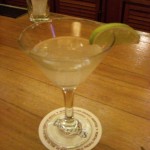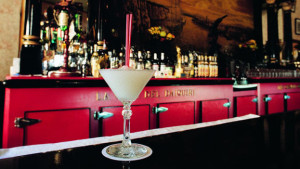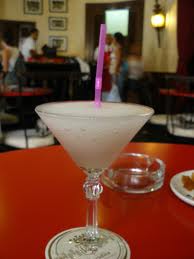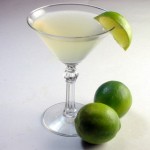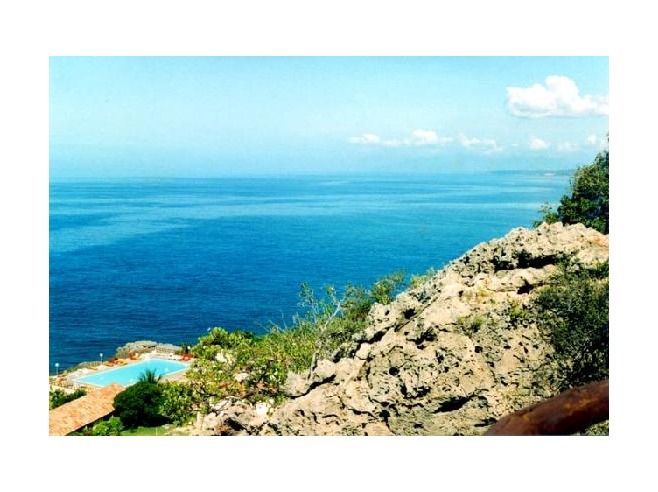INTERNATIONAL TRIBUTE TO THE CUBAN DAIQUIRÍ.
This past week was held in the famous Havana bar Floridita a gala in honor of the famous Catalan bartender Constantino Ribalaigua, “Constant”, whom some attribute the original of the Cuban mix, Daiquiri. During few days avid drinkers and bartenders from various countries of the world came to Havana to pay homage to Ribalaigua, died many years ago in Havana, and which will always be remembered for his mention in the writings of the famous american writer, living in Cuba for many years, Ernest Hemingway who never missed one week without visiting the site and praised the rich daiquiriana mix.
They recognized bartenders in Cuba, United States, Argentina, Canada and Puerto Rico paid tribute on Friday for the first time in his grave to Constantine Ribalaigua, “Constant”, a ritual that included the preparation of the famous daiquiri many tasters nice mix was its creation, though the story includes other versions of the real creators of the original Cuban drink.
Bartenders participate in the first international edition of the King of Daiquiri competition, organized by the Cuban Floridita bar, a favorite of the writer Hemingway (1899-1961) during their stay in Havana.
Nestled in the heart of Old Havana, on the corner of Obispo and Monserrate streets, the bar restaurant opened in 1817 under the name “La Piña de Plata” and since then has seen celebrities such as Ernest Hemingway, the boxer Rocky Marciano, the fashion designer Paco Rabanne and actor Jean Paul Belmondo, among others.
The US Nobel Prize contributed to the worldwide recognition of Cuban cocktails designed by the famous Catalan ‘Constante’ as “the President” or “the Papa Hemingway”, a variant of the classic recipe Daiquiri including lemon juice, rum, crushed ice and sugar substitutes grapefruit juice.
DAIQUIRI: Versions of its origin
Daiquiri name is also the name of a beach near Santiago de Cuba, and an iron mine in that area, and it is a word of Taino origin. The cocktail was invented around 1900 in a bar called Venus in Santiago, about 23 miles (37 kilometers) east of the mine by a group of American mining engineers. Among the engineers were present Jennings Cox, General Manager of the Spanish American Iron Co., Francisco J. Linthicum, C. Manning Combs, George W. Pfeiffer, De Berneire Whitaker, C. Proctor Merritt O. Holmes and Persing. Although the stories that Cox invented the drink when he ran out of gin while entertaining guests of America persist, drink evolved naturally due to the prevalence of lime and sugar.
The consumption of the drink remained localized until 1909, when Admiral Lucius W. Johnson, an official US Navy health, tried Cox drink. Johnson subsequently entered in the Army and Navy Club in Washington, DC, and Daiquiri drinkers has increased in the space of a few decades.
TRIBUTE TO THE CUBAN DRINK.
Originally the drink was served in a tall glass filled with crushed ice. A teaspoon of sugar was poured on ice and the juice of one or two lemons squeezed on sugar. Two or three ounces of rum completed the mixture. The frosted glass was then stirring with a long-handled spoon. Later, the Daiquiri evolved to be mixed in a shaker with the same ingredients but with shaved ice. After stirring thoroughly, she poured into a chilled flute glass. An article in the March 14, 1937 edition of The Miami Herald and the private correspondence of JF Linthicum confirm the prescription and early history.
The daiquiri was a favorite drink of Ernest Hemingway and President John F. Kennedy.
To my readers, I extend to them my best recipe Daiquiri Cuban.
Cuban rum 50 ml of light
25 ml of fresh lemon juice
15 ml sugar syrup, or the equivalent in granulated form.
Shake with ice, then strain into a cocktail glass. Garnish with a slice of lemon that has been cut and then placed on the edge of the glass.
The creation of the Catalan Constantine Ribalaigua, “Constant” called “Daiquiri Hemingway” in honor of the famous American writer and overlooking the large tourist population visiting the island to delight among other things the nice mix.
“Hemingway Daiquiri”
2 oz white rum (as DonQ Cristal)
.75 Oz lime juice
1 tsp maraschino
1 teaspoon grapefruit juice
1 teaspoon sugar
Shake with ice and strain into a chilled cocktail glass. Serve frappe (stacking crushed ice in the glass)
The drink became popular in the 1940s In wartime rationing made whiskey, vodka, etc., hard to find, however, due to the Good Neighbor policy of Roosevelt (who opened trade relations and travel with Latin America, Cuba and the Caribbean), rum was easy to obtain. The Good Neighbor Policy (also known as’ The program Panamericana “), helped make Latin America seem fashionable. The so drinks with rum (once frowned upon as the domain of sailors and below -and-outs), also it became fashionable, and the Daiquiri seen a tremendous increase in popularity in the US ..
The basic recipe for a daiquiri is also similar to the British sailors drank grog aboard the ship from 1740. In 1795 the Royal Navy daily ration of rum punch content, water, ¾ ounce of lemon juice, 2 ounces of sugar. This was a common drink throughout the Caribbean, and as soon as the ice became available this was included in place of water. Jennings Cox story is certainly very popular and perhaps was responsible for the name of the beverage, but as for the creation of what he was about 150 years late.
Wiki / InternetPhotos / YouTube / TheCubanHistory.com
The Cuban History, Hollywood.
Arnoldo Varona, Editor.
RINDEN HOMENAJE INTERNACIONAL AL DAIQUIRÍ CUBANO.
Reconocidos barmanes de Cuba, Estados Unidos, Argentina, Canadá y Puerto Rico rindieron tributo hoy viernes, por primera vez en su tumba, a Constantino Ribalaigua, Constante, con un ritual que incluyó la preparación del famoso daiquiri que muchos catadores de la agradable mezcla fue de su creación, aunque la historia recoge otras versiones de los verdaderos creadores de la bebida cubana.
Los cantineros participan en la primera edición internacional de la competición Rey del Daiquirí, organizada por el bar cubano Floridita, uno de los preferidos del escritor estadounidense Ernest Hemingway (1899-1961) durante sus estancias en La Habana.
Enclavado en el centro histórico de La Habana Vieja, en la esquina de las calles Obispo y Monserrate, este bar restaurante abrió sus puertas en 1817 bajo el nombre “La Piña de Plata” y desde entonces ha visto pasar a famosos como Ernest Hemingway, el boxeador Rocky Marciano, el diseñador de moda Paco Rabanne y el actor Jean Paul Belmondo, entre otros.
El premio nobel estadounidense contribuyó al reconocimiento mundial de cocteles cubanos ideados por el catalán Constante como el Presidente o el Papa Hemingway, una variante de la receta clásica del daiquirí que incluye zumo de limón, ron, hielo frappé y sustituye el azúcar por jugo de toronja.
DAIQUIRÍ: Versiones sobre su Origen
El nombre de Daiquiri es también el nombre de una playa cerca de Santiago de Cuba, y una mina de hierro en esa zona, y es una palabra de origen taíno. El cóctel fue inventado alrededor de 1900 en un bar llamado Venus en Santiago, a unos 23 millas (37 kilómetros) al este de la mina, por un grupo de ingenieros de minas de América. Entre los ingenieros estuvieron presentes Jennings Cox, General Manager of the Spanish American Iron Co., Francisco J. Linthicum, C. Manning Combs, George W. Pfeiffer, De Berneire Whitaker, C. Proctor Merritt Holmes y O. Persing. Aunque persisten las historias que Cox inventó la bebida cuando se le acabó la ginebra, mientras que entretener a los invitados de América, la bebida evolucionado de forma natural debido a la prevalencia de la lima y el azúcar.
El consumo de la bebida se mantuvo localizado hasta 1909, cuando el almirante Lucius W. Johnson, un oficial de Marina de los EE.UU. médica, trató la bebida de Cox. Johnson, posteriormente, introducido en el Ejército y la Marina del Club en Washington, DC, y los bebedores del daiquirí ha aumentado en el espacio de unas pocas décadas.
HOMENAJE A LA BEBIDA CUBANA.
Precisamente en estos días se ha celebrado en el muy conocido bar habanero el Floridita una gala en honor del famoso cantinero Catalán Constantino Ribalaigua, “Constante”, a quien algunos atribuyen la original mezcla cubana. En estos días avidos bebedores y barmans de varios países del mundo vinieron a la Habana a rendir homenaje a Ribalaigua, muerto hace ya muchos años en La Habana y que será recordado siempre por sus menciones en los escritos del famoso norteamericano Hemingway que no dejaba pasar una semana sin visitar el lugar y alabar la rica mezcla daiquiriana.
Originalmente la bebida se servía en un vaso alto lleno de hielo picado. Una cucharadita de azúcar se vertió sobre hielo y el jugo de la de uno o dos limones se exprimió sobre el azúcar. Dos o tres onzas de ron completado la mezcla. El vidrio esmerilado que entonces era removiendo con una cuchara de mango largo. Más tarde, el Daiquirí evolucionado para ser mezclado en una coctelera con los mismos ingredientes pero con hielo raspado. Después de una agitación a fondo, se vertió en un vaso flauta refrigerados. Un artículo del 14 de marzo 1937 edición de The Miami Herald, así como la correspondencia privada de JF Linthicum confirmar la receta y la historia temprana.
El daiquirí fue una de las bebidas favoritas del escritor Ernest Hemingway y el presidente John F. Kennedy.
Para mis lectores, les hago llegar la mejor receta de mi DAIQUIRI Cubano.
50 ml de ron cubano ligero
25 ml de jugo de limón fresco
Jarabe de azúcar 15 ml, o su equivalente en forma granulada.
Agitar con hielo, y luego colar en un vaso de cóctel. Adorne con una rodaja de limón, que ha sido cortado y luego se coloca en el borde del vaso.
La creación del Catalán Constantino Ribalaigua, “Constante” el llamado “Daiquiri Hemingway” en honor del famoso escritor norteamericano y con vista a la gran población turística que visita a la Isla para deleitar entre otras cosas la agradable mezcla.
“Daiquiri Hemingway”
2 oz ron blanco (al igual que DonQ Cristal)
.75 Oz jugo de lima
1 cucharadita de marrasquino
1 cucharadita de jugo de pomelo
1 cucharadita de azúcar
Agitar con hielo y verter en una copa de cóctel helada. Sirva frappe (hielo triturado apilado en el vidrio)
La bebida se hizo popular en la década de 1940. En tiempo de guerra de racionamiento hecho whisky, vodka, etc, difícil de encontrar, sin embargo, debido a la política del buen vecino de Roosevelt (que abrió las relaciones comerciales y de viajes con América Latina, Cuba y el Caribe), el ron era fácil de obtener. La Política del Buen Vecino (también conocido como ‘El programa de Panamericana “), ayudó a hacer de América Latina parecen de moda. Las bebidas lo tanto, a base de ron (una vez mal visto como el dominio de los marineros y de abajo-y-outs), también se puso de moda, y el Daiquirí visto un tremendo aumento en popularidad en los EE.UU..
La receta básica para un Daiquirí es también similar a los marineros británicos bebían grog a bordo del barco a partir del 1740. En 1795 la Royal Navy ración diaria de ron ponche contenido, el agua, ¾ de onza de jugo de limón, y 2 onzas de azúcar. Esta era una bebida común en todo el Caribe, y tan pronto como el hielo llegó a estar disponible este se incluyó en lugar del agua. Historia de Jennings Cox es sin duda muy popular y tal vez fue el responsable de la denominación de la bebida, pero en cuanto a la creación de lo que estaba a unos 150 años de retraso.
Wiki / InternetPhotos / YouTube / TheCubanHistory.com
The Cuban History, Hollywood.
Arnoldo Varona, Editor.



 FAMOUS DRINKS: International Tribute to the Cuban Daiquirí. *** Bebidas Famosas: Rinden Homenaje Internacional al Daiquirí Cubano.
FAMOUS DRINKS: International Tribute to the Cuban Daiquirí. *** Bebidas Famosas: Rinden Homenaje Internacional al Daiquirí Cubano.